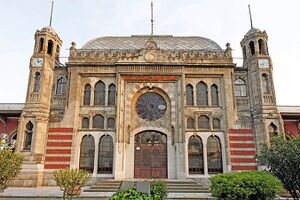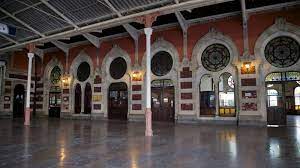Istanbul
| Istanbul | |||||
|---|---|---|---|---|---|
| Japanese Name | イスタンブール | ||||
| Weapon | |||||
| Race | Elf | ||||
| Nationality | |||||
| Birthday | October 29 | ||||
| Constellation | Scorpio | ||||
| Talents | Vanquishing demons with her divine-powered spear | ||||
| Likes | Faith, Rakı, Kebab, Dondurma | ||||
| Dislikes | Demons, Crusaders, Getting controlled by lust, Sexual things | ||||
| Strengths | Deep in faith, Possess mental strength to overcome worldly desires | ||||
| Weaknesses | Pleasure-sensitive | ||||
| Hobbies | Praying alone, Talking with believers in the confessional, Sama | ||||
Sister here belongs to the Holy Irisism, a branch of Irisism that is worshiped mainly within Verforet. It is a venerable religion that boasts the largest number of believers in the world. The clergy are called priests, the highest among them is the Patriarch, and Sister is the secondary Archbishop. Those with the title of Bishop are given their respective parishes, and are responsible for governing them, amen.
Layers
| Icon | Title | Release Date | Where to Obtain |
|---|---|---|---|
| [Suppressed Archbishop] Istanbul | 2023 June 9 | [Training Camp - Istanbul] Event Reward | |
| [Clergy and a Little Happiness] Istanbul | 2023 June 15 | [Knights Template's Glorious Collapse] Event Reward | |
| [The Lascivious Demon] Istanbul | 2023 June 15 | [Knights Template's Glorious Collapse] Pick Up Gacha, Premium Gacha |
Owned Skills
Trivia
- Istanbul's birthday is the opening date of Sirkeci railway station (also called Istanbul station in maps) in Istanbul, Turkey (formerly Constantinople) in 2013, opened as a relay station for the railway line Marmaray connecting Asia and Europe.
- Istanbul's religious theme, her ecstasy state is originated from real life Istanbul, an important site for Christianity.
- Istanbul's preaching of the Holy Irisism religion is likely inspired from is the hierarchy of Christianity and the position of the Church of Constantinople.
- Istanbul's inner voice mentions the Fourth Crusade, based on the historical Fourth Crusade, which was originally supposed to head for Jerusalem at the request of the Byzantine Empire (Eastern Roman Empire). However, a sequence of economic and political events culminated in the Crusader army's 1202 siege of Zara and the 1204 sack of Constantinople, the capital of the Greek Christian-controlled Byzantine Empire, rather than Egypt as originally planned. This led to the partitioning of the Byzantine Empire by the Crusaders.
- Rakı or raki is an alcoholic drink made of twice-distilled grapes. It is the national drink of Turkey. It is also popular in other Balkan countries as an apéritif as well as in Kazakhstan. It is often served with seafood or meze. It is comparable to several other alcoholic beverages available around the Mediterranean and the Middle East, e.g. pastis, ouzo, sambuca, arak and aguardiente.
- Kebab, or kebap or kabab is a type of cooked meat dish that originates from cuisines of the Middle East. Many variants of the category are popular around the world, including the skewered shish kebab and the doner kebab with bread.
- Dondurma is the common word in Turkish for all kinds of ice cream that is often used to refer to Turkish mastic ice cream in English. It typically includes the ingredients cream, whipped cream, salep (ground-up tuber of an orchid), mastic (plant resin), and sugar. It is believed to originate from the city and region of Kahramanmaraş, and hence is also known as Maraş ice cream.
- Sama (Turkish: Sema; Persian, Urdu and Arabic: سَمَاع, romanized: samā‘un) is a Sufi ceremony performed as part of the meditation and prayer practice dhikr. Sama means "listening", while dhikr means "remembrance". These performances often include singing, playing instruments, dancing, recitation of poetry and prayers, wearing symbolic attire, and other rituals. Sama is a particularly popular form of worship in Sufism. In 2005, UNESCO confirmed the "Mevlevi Sama Ceremony" of Turkey as one of the Masterpieces of the Oral and Intangible Heritage of Humanity.
- Grígoros Húdōr (γρήγορος ὕδωρ) is Greek for 'Quick Water'.
- The building in the background of [The Lasvicious Demon], also featured in the Special Skill, is the Sirkeci railway station's facade.
Counterpart
Sirkeci railway station (Turkish: Sirkeci garı), listed on maps as Istanbul railway station (Turkish: İstanbul garı), is a railway terminal in Istanbul, Turkey. The terminal is located in Sirkeci, on the tip of Istanbul's historic peninsula, right next to the Golden Horn and just northwest of Gülhane Park and the Topkapı Palace. Sirkeci Terminal on the European side of the Bosporus strait, along with Haydarpaşa Terminal on the Asian side, are Istanbul's two intercity and commuter railway terminals. Built in 1890 by the Oriental Railway as the eastern terminus of the world-famous Orient Express that once operated between Paris and Istanbul in the period between 1883 and 2009, Sirkeci Terminal has become a symbol of the city.
The construction of a new terminal building began on 11 February 1888. The terminus, which was initially named "Müşir Ahmet Paşa Station", was opened on 3 November 1890, replacing the temporary one. The architect of the project was August Jasmund, a Prussian who was sent to İstanbul by the German government in order to study Ottoman architecture, but lectured architectural design at the School of Polytechnics in İstanbul (now Istanbul Technical University). The terminal building which rises on an area of 1,200 m2 (13,000 sq ft) is one of the most famous examples of European Orientalism, and has influenced the designs of other architects. The building was also modern, having gas lighting and heating provided by large tile stoves, made in Austria, in winter.
As of 19 March 2013, service to the station was indefinitely suspended due to the rehabilitation of the existing line between Kazlıçeşme and Halkalı for the new Marmaray commuter rail line. On 29 October 2013, a new underground station was opened to the public and is serviced by Marmaray trains travelling across the Bosphorus. Sirkeci Terminal has a total of 4 platforms (3 above, 1 underground) with 7 tracks (5 above, 2 underground). Formerly, commuter trains to Halkalı would depart from tracks 2, 3 and 4; while regional trains to Kapıkule, Edirne and Uzunköprü, along with international trains to Bucharest, Sofia and Belgrade would depart from tracks 1 and 5.
The terminal restaurant became a meeting point for journalists, writers and other prominent people from the media in the 1950s and 1960s. The same restaurant, today called "Orient Express", is a popular spot among tourists. The station is preserved in its original state, but the areas around the terminal building have largely changed since 1890. The İstanbul Railway Museum, which opened in September 2005, is located in the station. Members of the Mevlevi Dervish order regularly conduct ceremonies at Sirkeci Terminal, which tourists and other members of the public can observe for an admission fee. Wikipedia
Map
Gallery
- Pages using Tabber parser tag
- Pages using DynamicPageList3 parser tag
- Weapon Spear
- Elf
- Verforet
- Scorpio
- Element Pierce
- Element Water
- Train Knights
- Turkey












